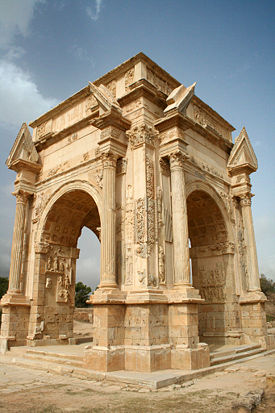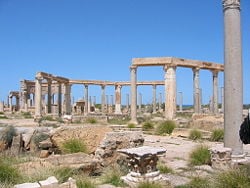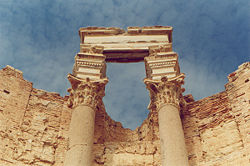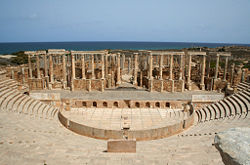Difference between revisions of "Leptis Magna" - New World Encyclopedia
Mary Anglin (talk | contribs) |
Mary Anglin (talk | contribs) |
||
| Line 40: | Line 40: | ||
===Modern history=== | ===Modern history=== | ||
| − | The ruins of Leptis Magna were pillaged throughout history, though for the most part, they lay buried by sand. Excavations began in the 1920s. At that time the Libyan Antiquities Service, as well as groups of [[Italy|Italian]] [[archaeology|archaeologists]], began laboring to preserve and study the site. The intervention of | + | The ruins of Leptis Magna were pillaged throughout history, though for the most part, they lay buried by sand. Excavations began in the 1920s. At that time the Libyan Antiquities Service, as well as groups of [[Italy|Italian]] [[archaeology|archaeologists]], began laboring to preserve and study the site. The intervention of British art historians and archaeologists were successful in preventing a radar station from being constructed on the site by the [[Royal Air Force]] during [[World War II]]. Many of the works of art uncovered at Leptis are displayed at the nearby Leptis Magna Museum or at the Al-Saraya Al-Hamra (castle) [[museum]] of archaeology and history in [[Tripoli]]. <ref name=EB/> |
| + | |||
| + | Teams of archaeologists working at Leptis have uncovered one of the best preserved Roman cities ever discovered. However, due to the political instability of [[Libya]], has it has remained less well-known than other sites. <ref name=Walda> | ||
| + | Hafed Walda. [http://www.alnpete.co.uk/lepcis/ Lepcis Magna, The Roman Empire in Africa]'' Lepcis Magna Excavations''. Retrieved April 24, 2008. </ref> | ||
| + | |||
| + | Excavations have uncovered traces of early [[Punic]] structures near the excavated shell of its [[amphitheatre]] and its old forum, which was the heart of the city in early Roman times. Also uncovered are: | ||
| + | |||
| − | |||
| − | |||
EB | EB | ||
| − | + | ||
| + | From this nucleus, the city spread westward along the coast and inland to the south. | ||
| + | |||
| + | Second-century buildings include well-preserved baths erected under the emperor Hadrian (117–138) and a circus (racecourse) some 1,500 feet (460 metres) long. The largest surviving monuments were erected during the reign of Severus. Linking the city centre to the harbour was a colonnaded street roughly 1,350 feet (410 metres) long that terminated in a circular piazza dominated by an intricately designed nymphaeum (ornamental fountain house). Leptis' two main roads intersected under a massive four-way arch, a tetrapylon, upon which the grandeur of Severus and his family was depicted in a frieze. Among the other structures erected during that period were an aqueduct 12 miles (19 km) long, an elaborate complex of buildings on the left bank of the wadi, and the Hunting Baths, which are extraordinarily well preserved, with colourfully painted scenes of hunting exploits (including a 2nd- or 3rd-century painting of a leopard hunt) and the still-legible names of honoured hunters on the walls. | ||
The basilica, which stood on the western side of the colonnaded street, was dedicated in 216 (five years after Severus' death). It was one of the grandest buildings constructed at Leptis. Measuring 525 feet (160 metres) long and 225 feet (69 metres) wide, it was a three-aisled, colonnaded hall with an apse at each end. Flanking the apses were ornately sculpted pilasters depicting the Life of Dionysus and the Twelve Labours of Hercules (both favourites of the Severus family). Adjoining the basilica was the new forum, elaborately adorned with imported marble and granite. A central component of the forum was a temple honouring the emperor Severus and the imperial family. | The basilica, which stood on the western side of the colonnaded street, was dedicated in 216 (five years after Severus' death). It was one of the grandest buildings constructed at Leptis. Measuring 525 feet (160 metres) long and 225 feet (69 metres) wide, it was a three-aisled, colonnaded hall with an apse at each end. Flanking the apses were ornately sculpted pilasters depicting the Life of Dionysus and the Twelve Labours of Hercules (both favourites of the Severus family). Adjoining the basilica was the new forum, elaborately adorned with imported marble and granite. A central component of the forum was a temple honouring the emperor Severus and the imperial family. | ||
| Line 70: | Line 77: | ||
1997 will be largely a study season when the artefacts and other evidence can be examined to piece together answers to some of the intriguing questions this dig has raised - What happened to the 2nd/3rd centuries? Why did such a small house need extensive underground water cisterns? Where did we leave our trowel? To view a multimedia presentation on the excavation work being undertaken, and possible answers to these questions, come to our lecture theatre by clicking here. | 1997 will be largely a study season when the artefacts and other evidence can be examined to piece together answers to some of the intriguing questions this dig has raised - What happened to the 2nd/3rd centuries? Why did such a small house need extensive underground water cisterns? Where did we leave our trowel? To view a multimedia presentation on the excavation work being undertaken, and possible answers to these questions, come to our lecture theatre by clicking here. | ||
| − | |||
| − | |||
| − | |||
Revision as of 05:01, 24 April 2008
| Archaeological Site of Leptis Magna* | |
|---|---|
| UNESCO World Heritage Site | |

| |
| State Party | 22px Libyan Arab Jamahiriya |
| Type | Cultural |
| Criteria | i, ii, iii |
| Reference | 183 |
| Region** | Arab States |
| Inscription history | |
| Inscription | 1982 (6th Session) |
| * Name as inscribed on World Heritage List. ** Region as classified by UNESCO. | |
Leptis Magna, also known as Lectis Magna (or Lepcis Magna as it is sometimes spelled), also called Lpqy or Neapolis, was a prominent city of the Roman Empire. Its ruins are located in Al Khums, Libya, 130 km east of Tripoli, on the coast where the Wadi Lebda meets the sea. The site is one of the most spectacular and unspoilt Roman ruins in the Mediterranean.
History
Ancient history
Leptis Magna was the largest city of the ancient region of Tripolitania, located on the North African coast of the Mediterranean Sea in what is now Libya. The present-day city of Al-Khums is located 2 miles west of the ancient site. [1]
The city is believed to have been founded by Phoenicians of Tyre or Sidon in approximately the 10th century B.C.E. Carthaginians later settled in Leptis Magna around the end of the 6th century B.C.E. Within one hundred years it had become prominent as Carthage became a major power in the Mediterranean. Its harbor at the mouth of the Wadi Labdah placed it in a prime position as a Mediterranean and trans-Saharan trade center. The thriving agriculture in the fertile coastal region turned Leptis Magna into an important market center.
It became a Punic city, passing to Masinissa's Numidian kingdom in 202 B.C.E. It eventually broke away and became an ally of Rome, becoming a part of the new Roman province of Africa around 23 B.C.E., although from about 200 B.C.E. onward it was for all intents and purposes an independent city. It retained a number of its Punic legal and cultural traditions, including its municipal constitution and the official use of the Punic language. [1] It soon prospered and became one of the leading cities of Roman Africa and a major trading post.
Leptis achieved its greatest prominence beginning in 193, when a native son, Lucius Septimius Severus, became emperor. He favored his hometown above all other provincial cities, and the buildings and wealth he lavished on it made Leptis Magna the third most-important city in Africa, rivaling Carthage and Alexandria. Under Severus' direction an ambitious building program was initiated, including the creation of a new forum and the rebuilding of the docks and harbor.
Soon Leptis overextended itself and began to decline due in part to increasing insecurity of the frontiers. As a part of Roman Africa, it was affected by what became known as the Crisis of the Third Century - the crumbling and near collapse of the Roman Empire between 235 and 284. This was caused by three simultaneous crises: external invasion, internal civil war, and economic collapse. The changes in the institutions, society, economic life and eventually religion were so profound and fundamental, that the this period is increasingly seen as the watershed marking the difference between the classical world and the early medieval world, or world of late antiquity.
With this instability in the Empire, Leptis Magna's importance also fell into a decline, and by the middle of the fourth century, large parts of the city had been abandoned and fell into ruin.
The historian Ammianus Marcellinus recounts that the crisis was worsened by a corrupt Roman governor named Romanus during a major tribal raid who demanded bribes to protect the city. The ruined city could not pay these, and complained to the emperor Valentianian. Romanus then bribed people at court and arranged for the Leptan envoys to be punished 'for bringing false accusations'. It enjoyed a minor renaissance beginning in the reign of the emperor Theodosius I.
In 439, Leptis Magna and the rest of the cities of Tripolitania fell under the control of the Vandals when their king, Gaiseric, captured Carthage from the Romans and made it his capital. Unfortunately for the future of Leptis Magna, Gaiseric ordered the city's walls demolished so as to dissuade its people from rebelling against Vandal rule. But the people of Leptis and the Vandals both paid a heavy price for this in 523, when a group of Berber raiders sacked the city.
Belisarius recaptured Leptis Magna in the name of Rome 10 years later, and in 534 he destroyed the kingdom of the Vandals. Leptis became a provincial capital of the Eastern Roman Empire, but never recovered from the destruction wreaked upon it by the Berbers. The massacre of all the Berber chiefs of the Levathes, ordered by Duke Sergius at Leptis Magna in 543, provoked a terrible insurrection, through which the Romans nearly lost Africa. [2] By the time of the Arab conquest of Tripolitania in the 642, the city was abandoned except for a Byzantine garrison force.
Modern history
The ruins of Leptis Magna were pillaged throughout history, though for the most part, they lay buried by sand. Excavations began in the 1920s. At that time the Libyan Antiquities Service, as well as groups of Italian archaeologists, began laboring to preserve and study the site. The intervention of British art historians and archaeologists were successful in preventing a radar station from being constructed on the site by the Royal Air Force during World War II. Many of the works of art uncovered at Leptis are displayed at the nearby Leptis Magna Museum or at the Al-Saraya Al-Hamra (castle) museum of archaeology and history in Tripoli. [1]
Teams of archaeologists working at Leptis have uncovered one of the best preserved Roman cities ever discovered. However, due to the political instability of Libya, has it has remained less well-known than other sites. [3]
Excavations have uncovered traces of early Punic structures near the excavated shell of its amphitheatre and its old forum, which was the heart of the city in early Roman times. Also uncovered are:
EB
From this nucleus, the city spread westward along the coast and inland to the south.
Second-century buildings include well-preserved baths erected under the emperor Hadrian (117–138) and a circus (racecourse) some 1,500 feet (460 metres) long. The largest surviving monuments were erected during the reign of Severus. Linking the city centre to the harbour was a colonnaded street roughly 1,350 feet (410 metres) long that terminated in a circular piazza dominated by an intricately designed nymphaeum (ornamental fountain house). Leptis' two main roads intersected under a massive four-way arch, a tetrapylon, upon which the grandeur of Severus and his family was depicted in a frieze. Among the other structures erected during that period were an aqueduct 12 miles (19 km) long, an elaborate complex of buildings on the left bank of the wadi, and the Hunting Baths, which are extraordinarily well preserved, with colourfully painted scenes of hunting exploits (including a 2nd- or 3rd-century painting of a leopard hunt) and the still-legible names of honoured hunters on the walls.
The basilica, which stood on the western side of the colonnaded street, was dedicated in 216 (five years after Severus' death). It was one of the grandest buildings constructed at Leptis. Measuring 525 feet (160 metres) long and 225 feet (69 metres) wide, it was a three-aisled, colonnaded hall with an apse at each end. Flanking the apses were ornately sculpted pilasters depicting the Life of Dionysus and the Twelve Labours of Hercules (both favourites of the Severus family). Adjoining the basilica was the new forum, elaborately adorned with imported marble and granite. A central component of the forum was a temple honouring the emperor Severus and the imperial family.
Work in the late 20th century included the uncovering of Roman villas on the outskirts of Leptis. In the 1990s excavations within the city revealed a Roman house with an intact water system, including a well and underground cisterns.
In 1994 a new excavation of part of the site was started by a team of professional archaeologists from a variety of academic and research institutes around the UK. Led by Dr. Hafed Walda of Kings College London, and sponsored by the Society for Libyan Studies (established as a British Institute Abroad in 1969 and based at the Institute of Archaeology in London), this team has been conducting excavations of a building by the theatre for two seasons.
1997 will be largely a study season when the artefacts and other evidence can be examined to piece together answers to some of the intriguing questions this dig has raised - What happened to the 2nd/3rd centuries? Why did such a small house need extensive underground water cisterns? Where did we leave our trowel? To view a multimedia presentation on the excavation work being undertaken, and possible answers to these questions, come to our lecture theatre by clicking here.
Today, the site of Leptis Magna is the site of some of the most impressive ruins of the Roman period.
New discoveries
In June 2005 it was revealed that archaeologists from the University of Hamburg had been working along the coast of Libya when they uncovered a 30 ft length of five colorful mosaics created during the 1st or 2nd century. The mosaics show with exceptional clarity depictions of a warrior in combat with a deer, four young men wrestling a wild bull to the ground, and a gladiator resting in a state of fatigue, staring at his slain opponent. The mosaics decorated the walls of a cold plunge pool in a bath house within a Roman villa at Wadi Lebda in Leptis Magna. The gladiator mosaic is noted by scholars as one of the finest examples of representational mosaic art ever seen — a "masterpiece comparable in quality with the Alexander mosaic in Pompeii." The mosaics were originally discovered in 2000, but were kept secret to avoid looting. They are currently on display in the Leptis Magna Museum.[4]
Notes
- ↑ 1.0 1.1 1.2 Encyclopædia Britannica Online. 2008. Leptis Magna Retrieved April 23, 2008.
- ↑ Catholic Encylopedia, Volume IX. 1910. Leptis Magna Retrieved April 24, 2008.
- ↑ Hafed Walda. Lepcis Magna, The Roman Empire in Africa Lepcis Magna Excavations. Retrieved April 24, 2008.
- ↑ Alberge, Dalya, "Roman Mosaic 'Worthy of Botticelli", The Times Online, June 2005. Retrieved December 20, 2007.
ReferencesISBN links support NWE through referral fees
- Bianchi Bandinelli, Ranuccio, Ernesto Vergara Caffarelli, Giacomo Caputo, and Fabrizio Clerici. 1966. The buried city; excavations at Leptis Magna. New York: F.A. Praeger.
- Birley, Anthony Richard. 1972. Septimius Severus; the African emperor. Garden City, N.Y.: Doubleday.
- Di Vita, Antonino, Ginette di Vita-Evrard, Lidiano Bacchielli, and Robert Polidori. 1999. Libya: the lost cities of the Roman Empire. Cologne, Germany: Könemann. ISBN 9783895088445
- Goodchild, R.G. 1954. Tabula Imperii Romani - Map of the Roman Empire - Lepcis Magna. Society of Antiquaries of London.
- Matthews, Kenneth D. 1957. Cities in the sand, Leptis Magna and Sabratha in Roman Africa. Philadelphia: University of Pennsylvania Press.
- Talbert, Richard J. A., and Roger S. Bagnall. Barrington Atlas of the Greek and Roman World. Princeton, N.J.: Princeton University Press, 2000. ISBN 069103169X
- Ward-Perkins, J. B., and J. M. C. Toynbee. 1949. The hunting baths at Lepcis Magna. Oxford: Printed by C. Batey for the Society of Antiquaries of London.
External links
All links Retrieved December 20, 2007.
- Comprehensive website, by an archaeologist working on the site
- The Circus at Leptis Magna - Satellite View Google Maps
Credits
New World Encyclopedia writers and editors rewrote and completed the Wikipedia article in accordance with New World Encyclopedia standards. This article abides by terms of the Creative Commons CC-by-sa 3.0 License (CC-by-sa), which may be used and disseminated with proper attribution. Credit is due under the terms of this license that can reference both the New World Encyclopedia contributors and the selfless volunteer contributors of the Wikimedia Foundation. To cite this article click here for a list of acceptable citing formats.The history of earlier contributions by wikipedians is accessible to researchers here:
The history of this article since it was imported to New World Encyclopedia:
Note: Some restrictions may apply to use of individual images which are separately licensed.


